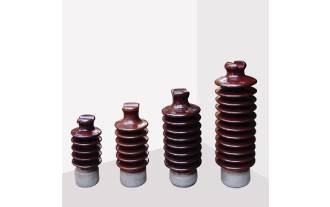Composite insulators have certain advantages over ceramic insulators, and their application rate has grown rapidly. For example, it is estimated that in China, composite insulators currently account for more than one-third of the total number of insulators on all transmission lines. In the new line, they account for nearly 50% of all installed insulators, and in terms of UHV, they are currently the dominant type.
The earliest porcelain stay insulators have been used for more than 40 years, and in China, its use history is about 30 years. Considering their spiral use and years of use, research on the methods of monitoring defects or damage in use has become the most important. There are many potential failure modes that represent potential threats to the safe operation of composite insulators, including flashover, aging, and mechanical failure.
In the first category, lightning flashover is usually the most common threat to these insulators, mainly because it depends on the dry arc distance and has little relationship with the insulator material. If the dry arc distance of the composite insulator is the same as the dry arc distance of the porcelain string or the glass string, the flashover withstand capability is basically the same. Although composite insulators cannot increase the lightning flashover voltage, they cannot reduce the lightning performance of the line. In any case, auto-reclosing is usually successful in this case, so this potential problem has a relatively low impact on network reliability.
Because the silicone rubber shell has excellent hydrophobicity and hydrophobic transmission characteristics, the composite insulator has excellent pollution performance. This translates into relatively few pollution flashovers, which is one of the main reasons for its widespread use. On the other hand, the flashover caused by bird droppings poses a bigger problem, mainly because large birds release a “streamer” near the top of the insulator, which is essentially equivalent to a part of the conductor “floating in the air”, Thereby greatly distorting the electric field D of the insulator. distribution. In addition, if the streamer is close to the edge of the insulator, the distortion in the electric field is greater and it is more likely to cause a flashover. Composite insulators are more prone to flashover due to bird streamers than porcelain strings or glass strings because their shed diameter is small. In fact, most of the flashover failures recorded as unexplained were probably triggered by birds.
The second major threat to composite insulators is aging, which involves the occurrence of surface phenomena, such as cracking or cracking under natural weathering. The aging of silicone rubber is often accompanied by a decrease in hydrophobicity and a corresponding decrease in the ability to withstand flashover. However, aging can also be caused by other factors, such as bird pecks that can damage silicone sheds, or sustained strong winds that can tear sheds according to diameter and design. Mechanical failure is the third major type of problem that may occur, mainly involving the breakage of the core of the composite insulator, causing the conductor to fall off.

Porcelain Stay Insulators
Basically, the operation monitoring of suspension insulators includes inspections to determine the type and extent of damage associated with these possible failure modes. In the case of lightning flashover, a lightning positioning system is usually provided, which can help maintenance personnel locate the affected tower. In China, the policy of power supply companies is to determine which composite insulators have undergone lightning flashover and replace them to eliminate the potential risk of damage. Online leakage current monitoring is usually used to evaluate its ability to withstand flashover. For arcs caused by bird streamers, the inspection is used to find large birds in the nest on or near the tower. Similarly, when it comes to the aging and damage of silicone sheds, visual inspection is the main technique—whether or not with the help of optical equipment.
Fracture failure of the FRP core rod is the most serious potential failure mode for composite insulators and the most difficult failure mode to monitor. To make the situation more complicated, two unique and different types of fractures have been identified. One is the typical brittle fracture, which has been a research hotspot for many years and has been successfully simulated in the laboratory. Another type has occurred many times in China in recent years, resulting in a very different appearance of the fractured section. For example, a composite insulator with this failure mode was removed from a 500 kV AC line in Guizhou Province. One month before the fracture, infrared measurement found that the insulator's local temperature increased. When a voltage was applied to the broken insulator in the laboratory, a discharge was detected at a location where the temperature increased. This shows that the method of combining infrared cameras and the ultraviolet cameras can detect this new type of fracture failure mode through on-site inspection. In fact, several countries now have helicopter inspections of both devices.
Although the current online monitoring methods for composite insulators are diverse, they rarely meet all the standards that are simple, effective, and convenient. Therefore, the study found that the improved monitoring technology in use must continue to ensure the long-term reliable operation of the growing population of composite insulators.
+86 319 878 9350
+86 156 1304 7999
+86 319 878 9350
NanYan, DongHuan Road, Shahe, Hebei China
Copyright © Hebei Yipeng Line Equipment Co., Ltd. All Rights Reserved. | Sitemap Powered By 
